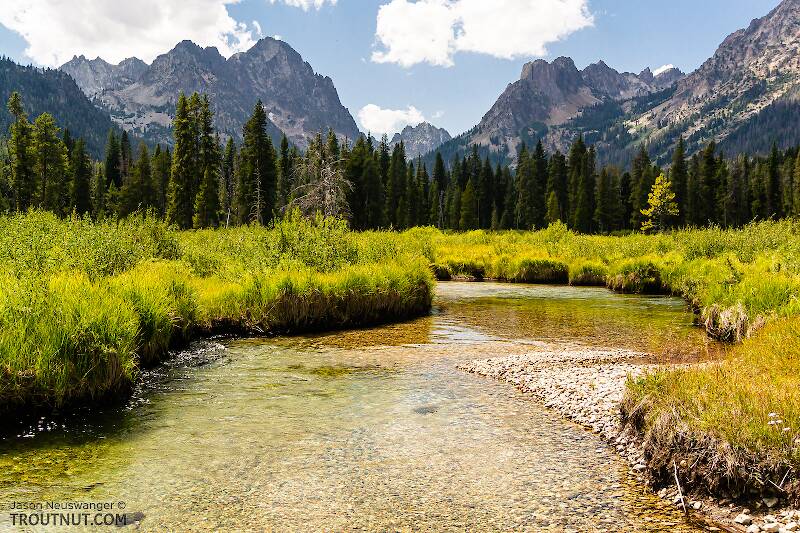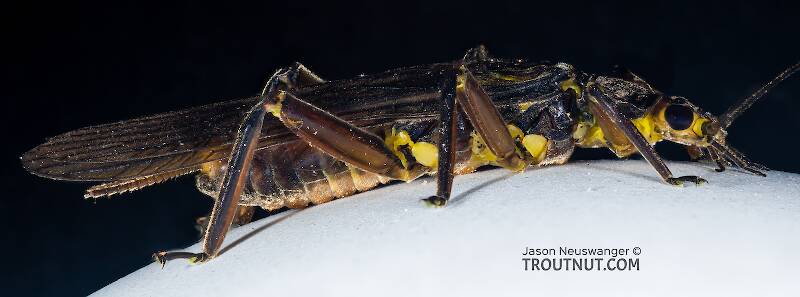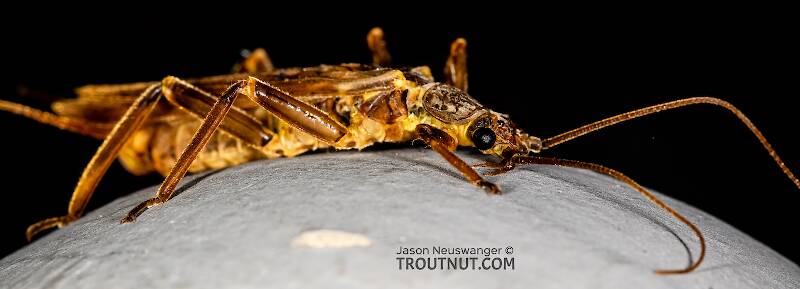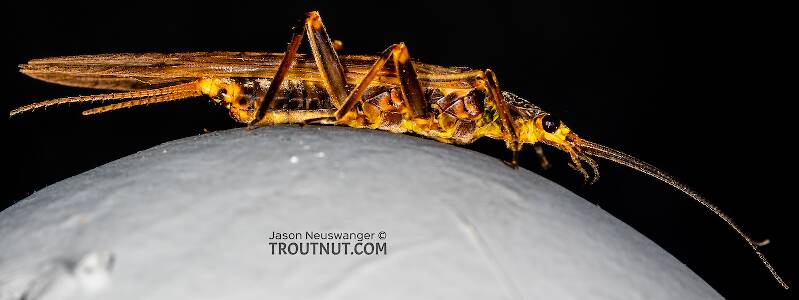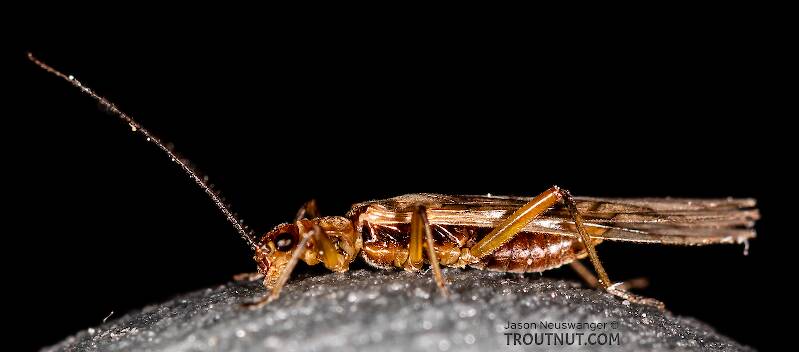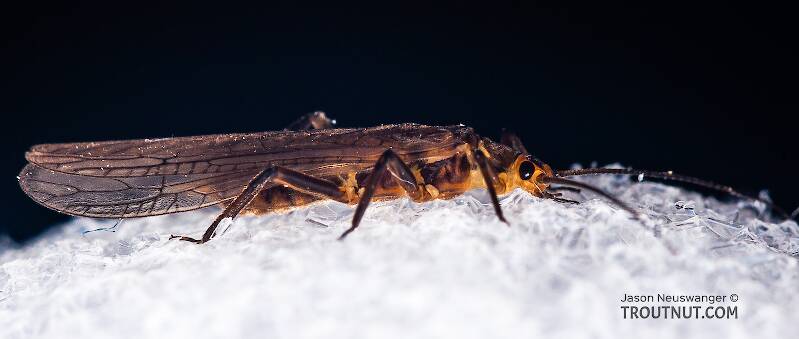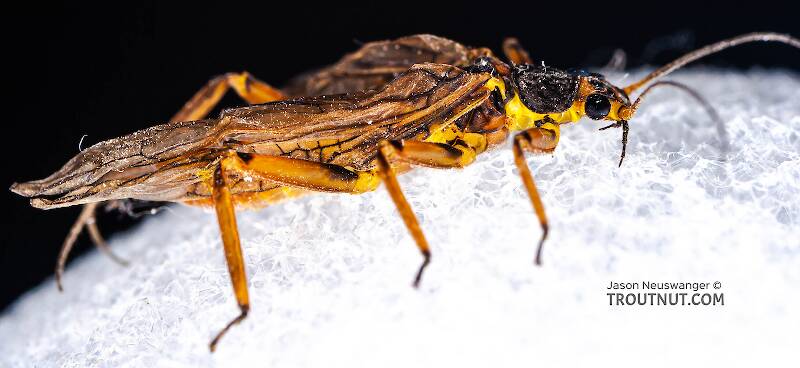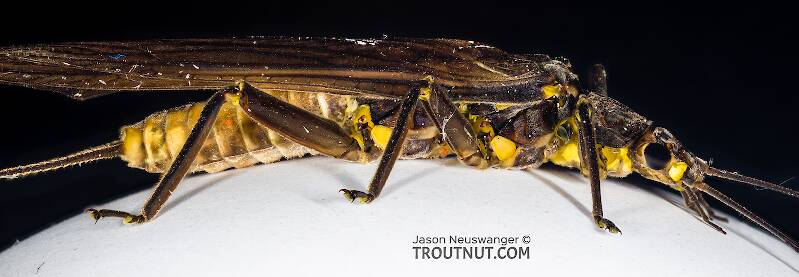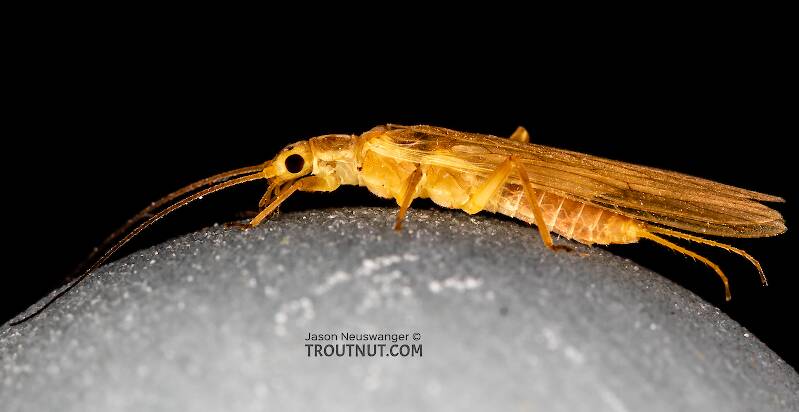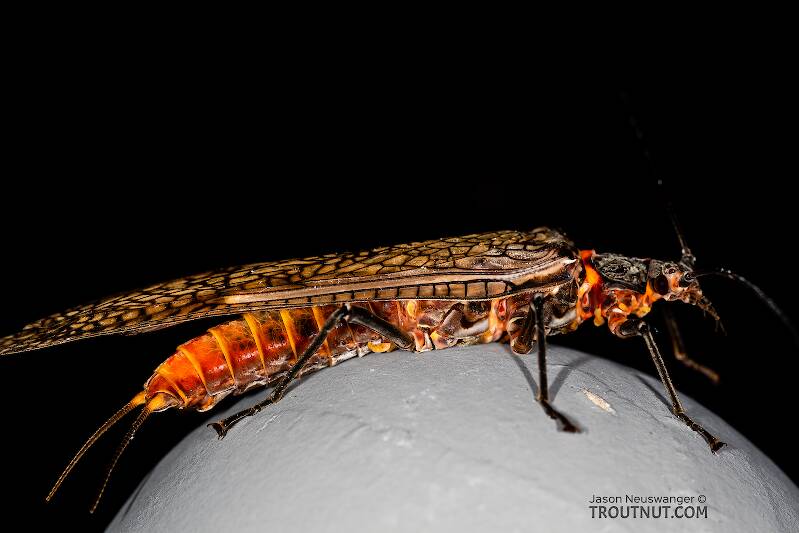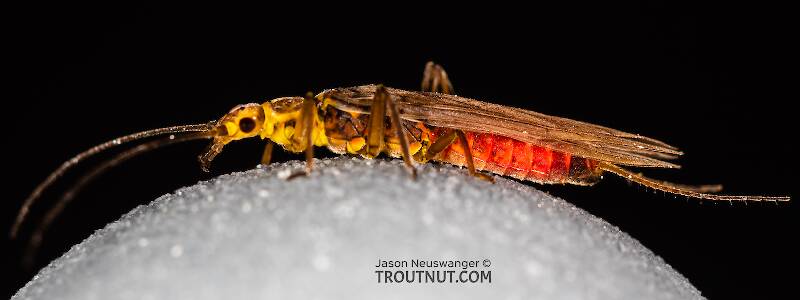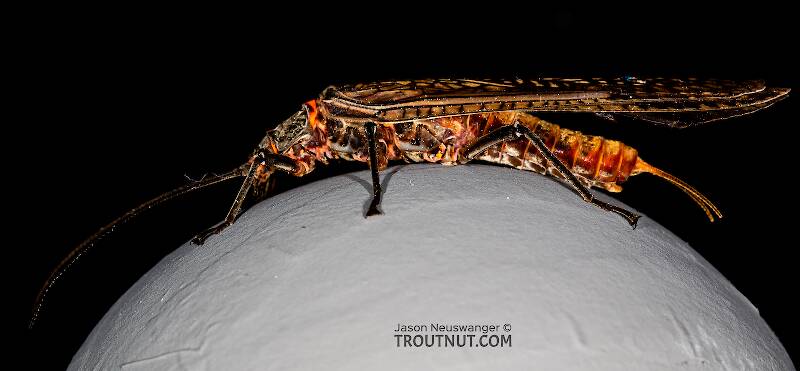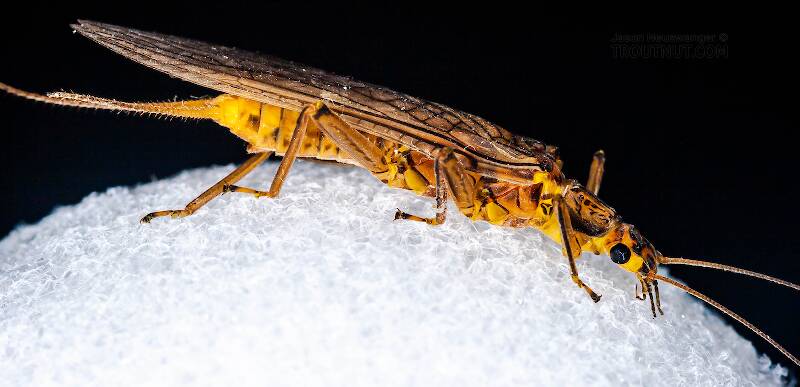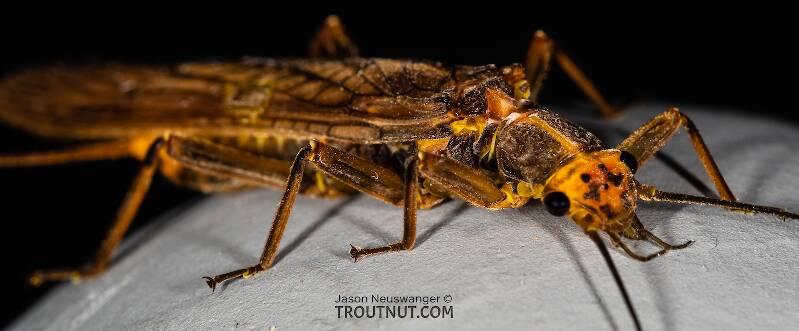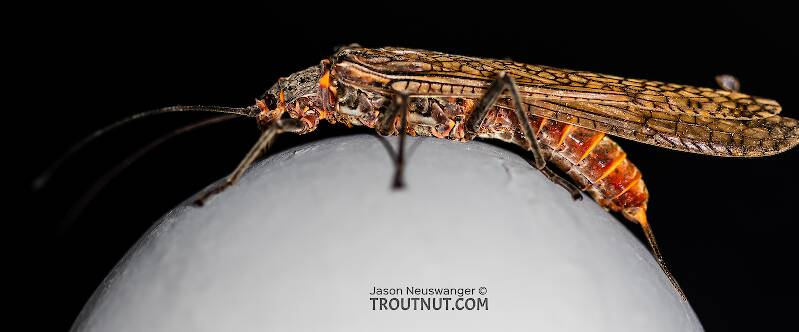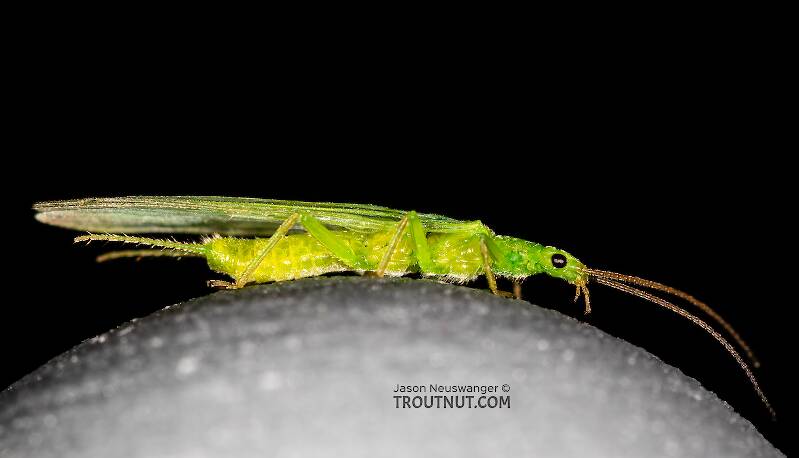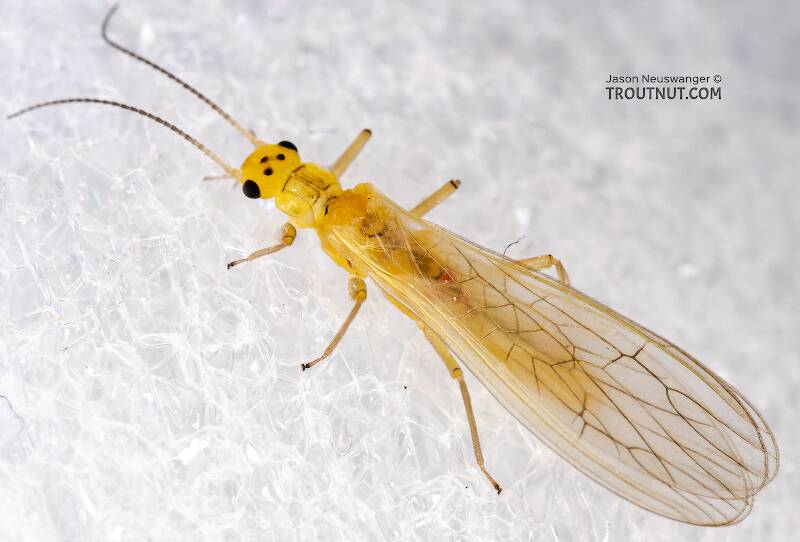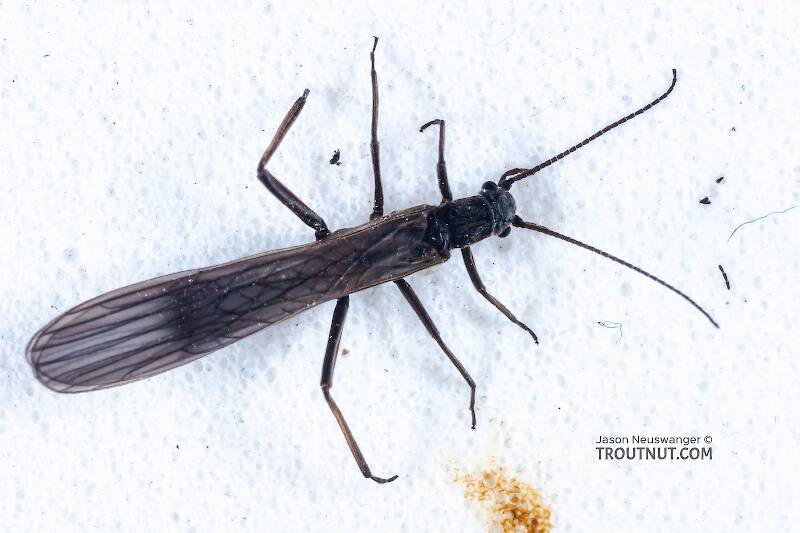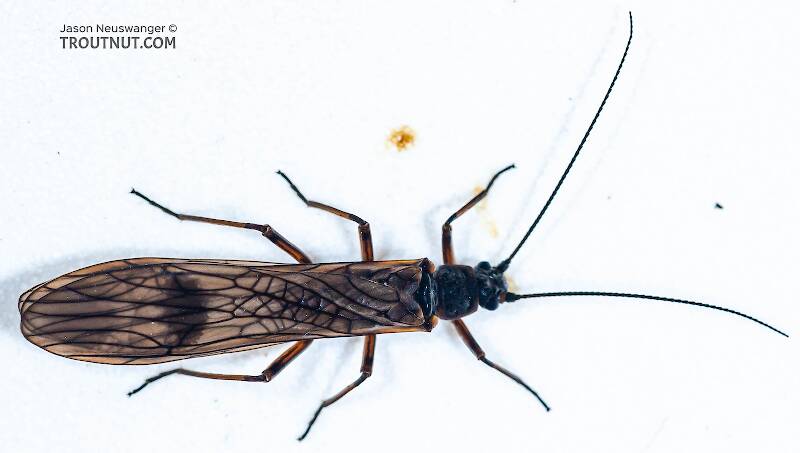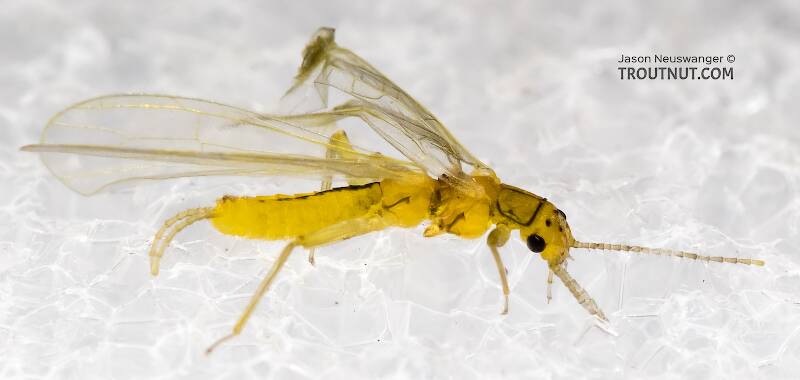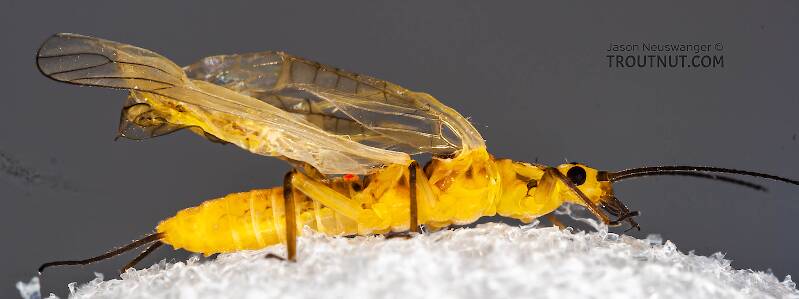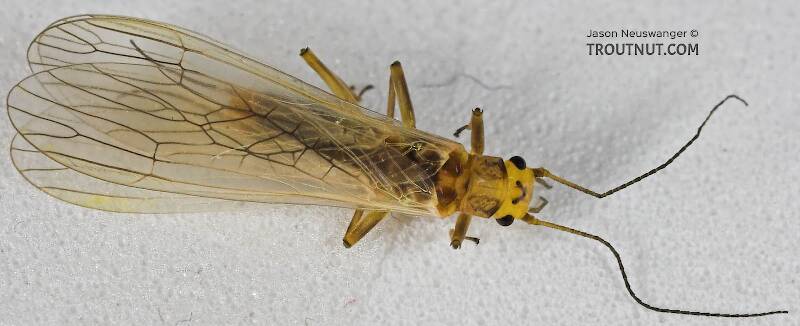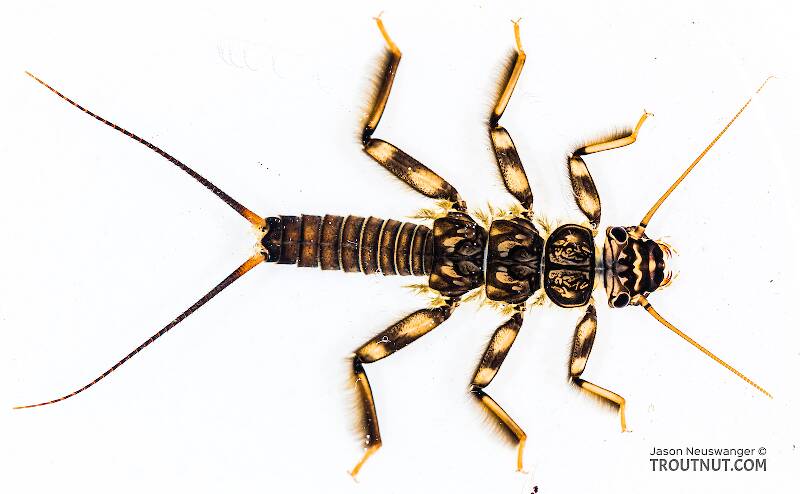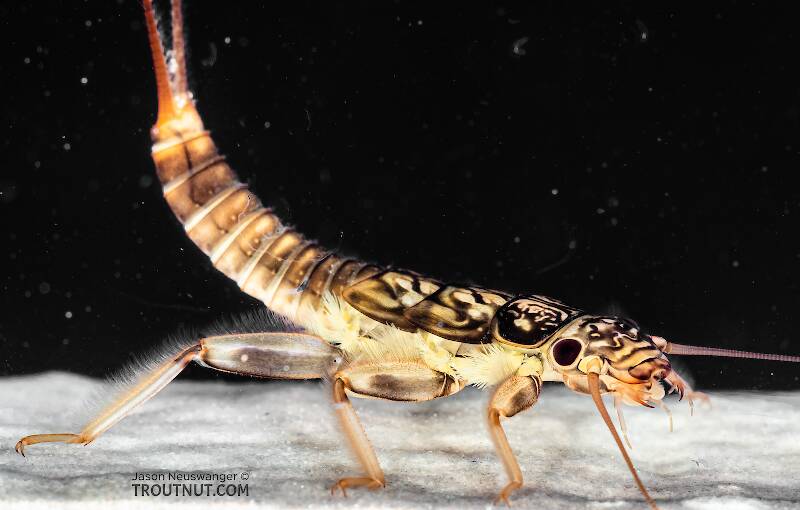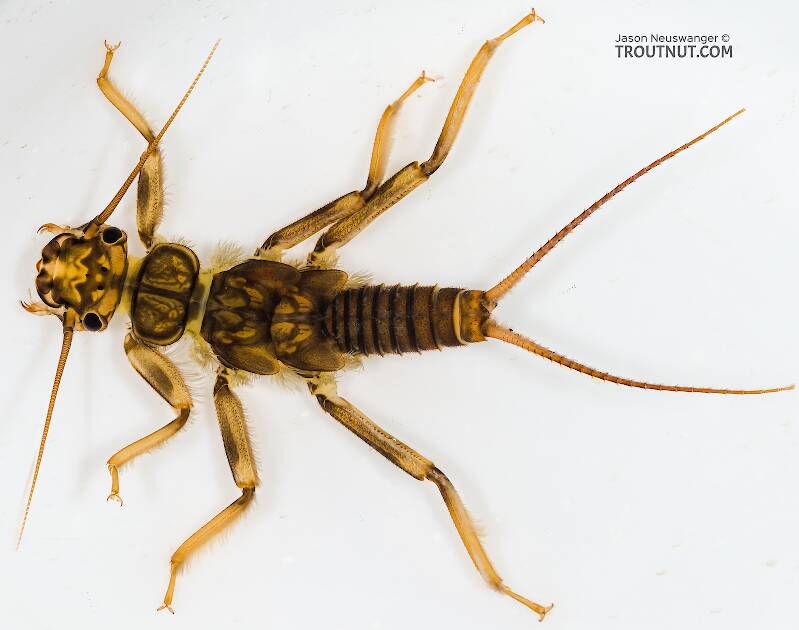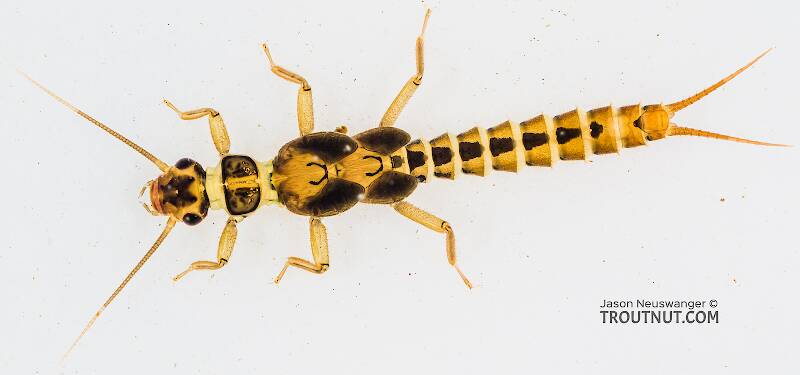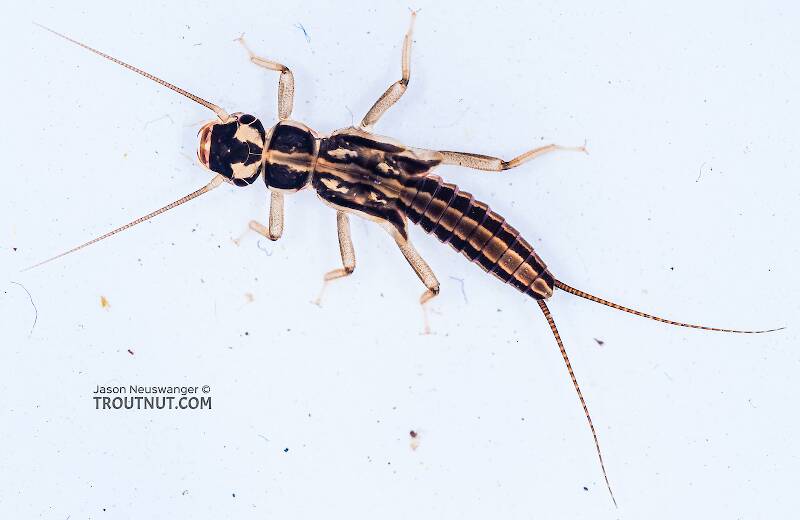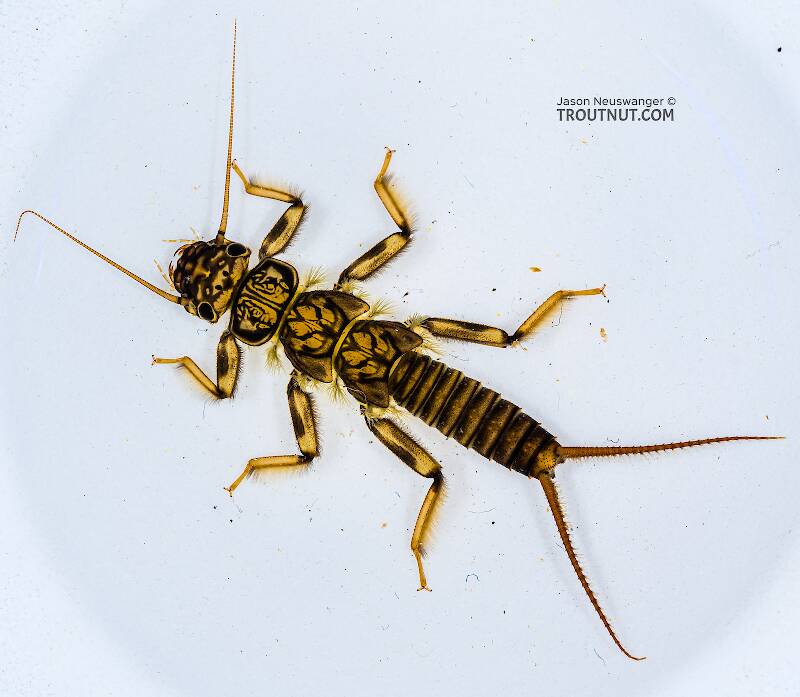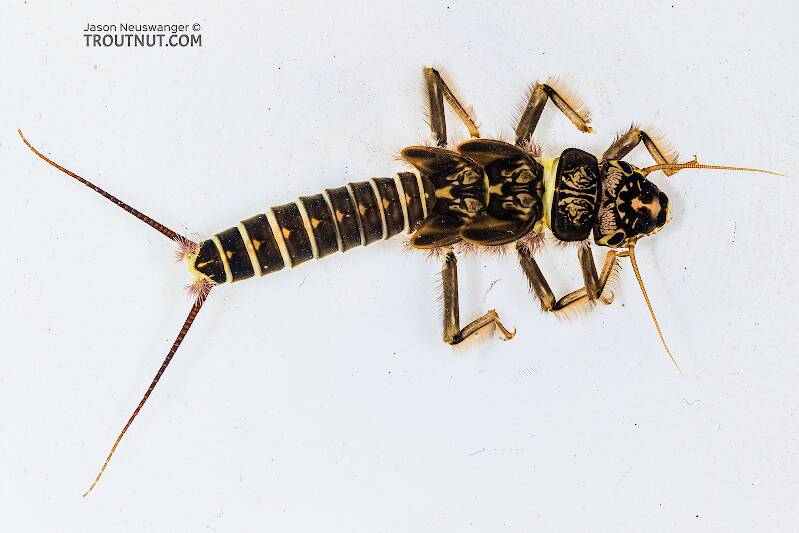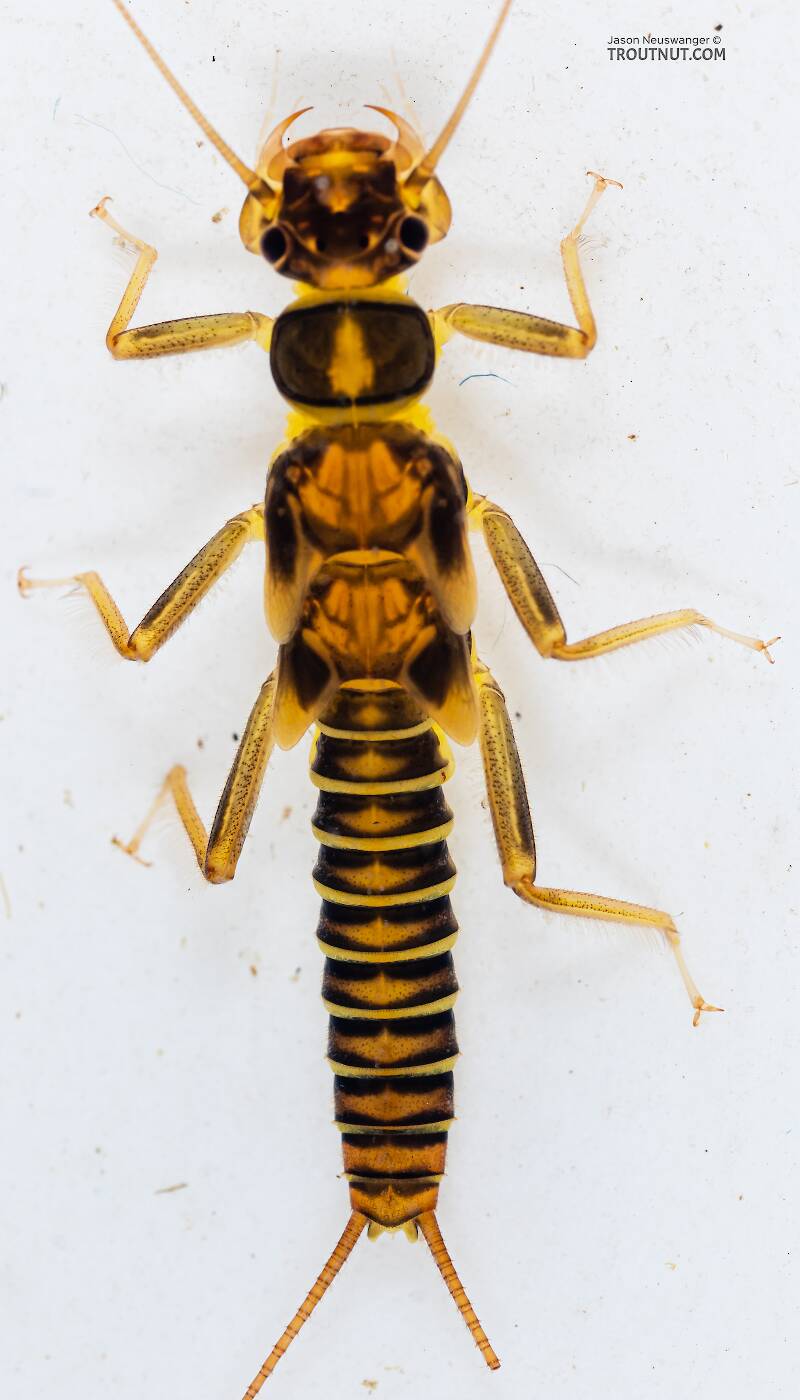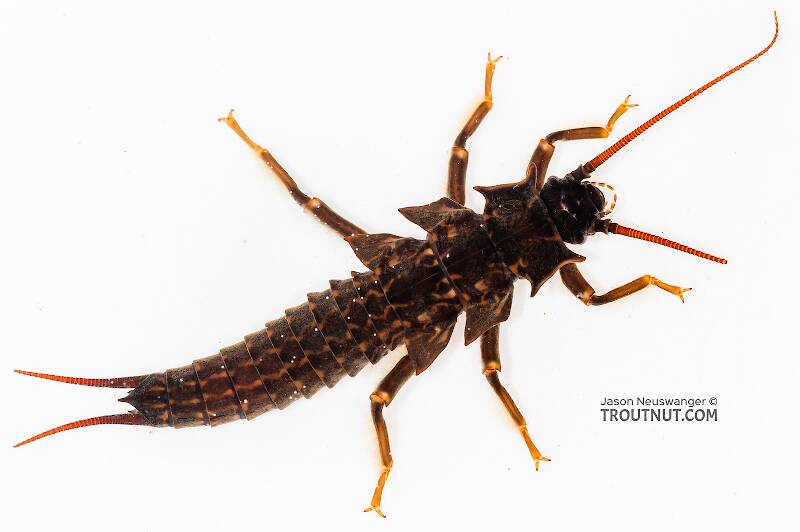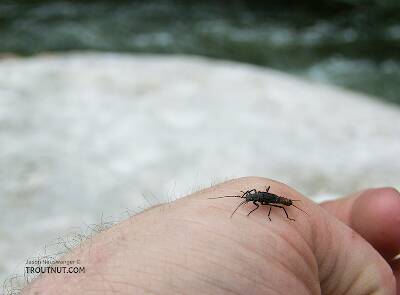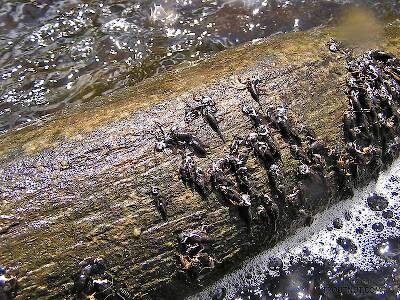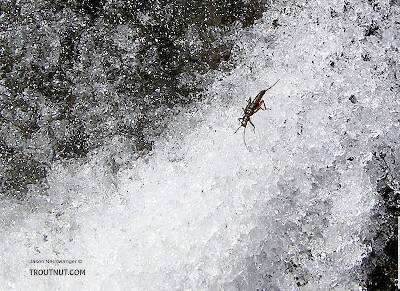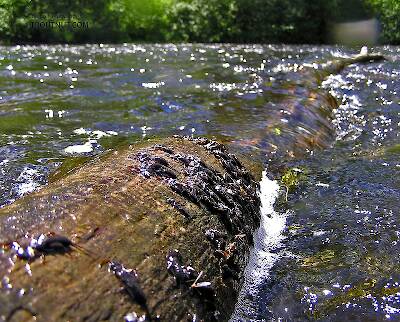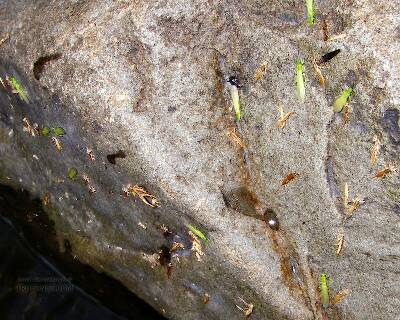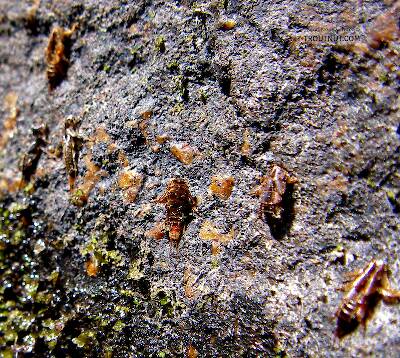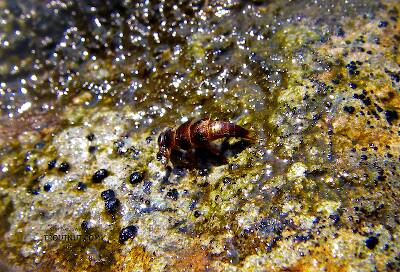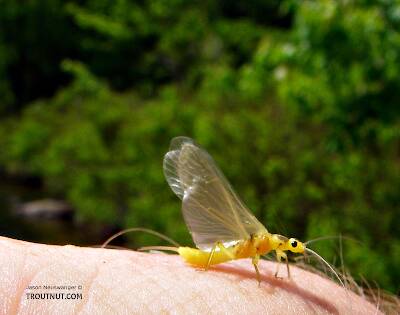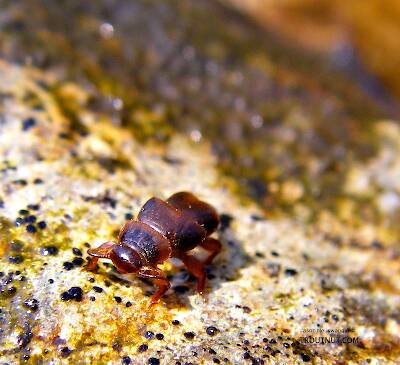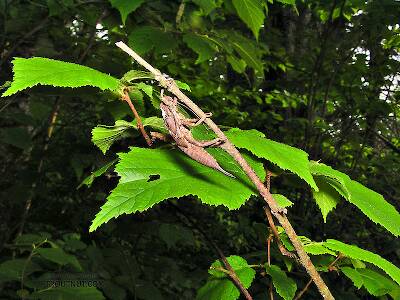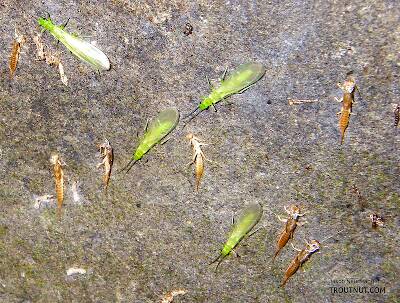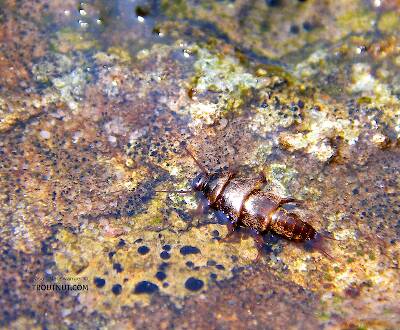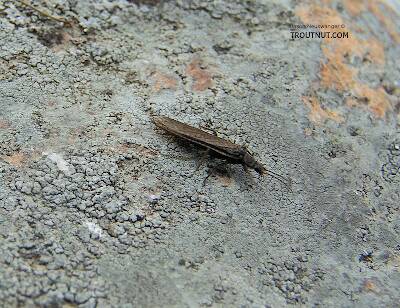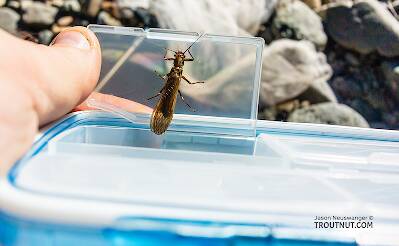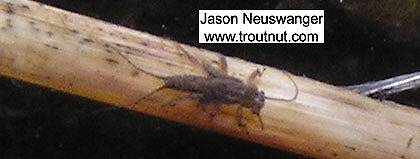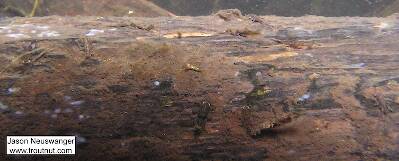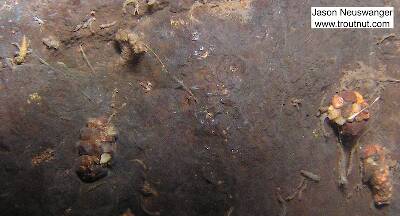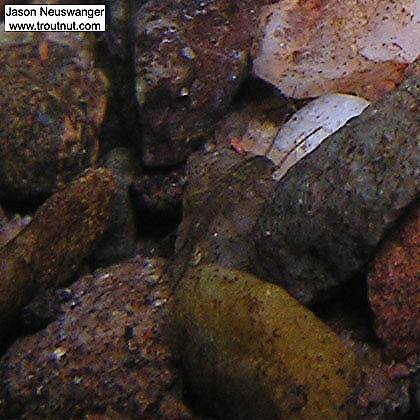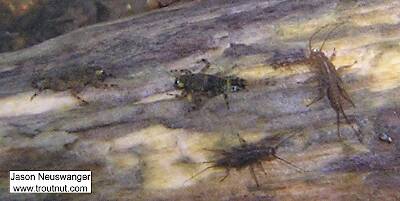
Salmonflies
Pteronarcys californica
The giant Salmonflies of the Western mountains are legendary for their proclivity to elicit consistent dry-fly action and ferocious strikes.
Featured on the forum

This is the first of it's family I've seen, collected from a tiny, fishless stream in the Cascades. The three species of this genus all live in the Northwest and are predators that primarily eat stonefly nymphs Merritt R.W., Cummins, K.W., and Berg, M.B. (2019).

Troutnut is a project started in 2003 by salmonid ecologist Jason "Troutnut" Neuswanger to help anglers and
fly tyers unabashedly embrace the entomological side of the sport. Learn more about Troutnut or
support the project for an enhanced experience here.
Insect Order Plecoptera (Stoneflies)
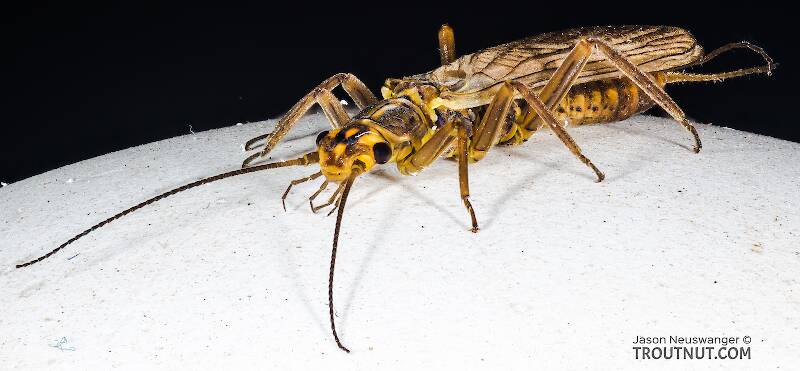
The year begins with the little dark stoneflies of the Capniidae, Leuctridae, and Nemouridae families as some of the only active aquatic insects available to trout. As the year progresses into late Winter and early Spring, the Large Springflies of the Perlodidae family in the West and Willowflies of the Taeniopterygidae are sometimes the first dry-fly insects of the season. When Spring fully arrives, so do the most significant stoneflies for the angler - the gigantic Pteronarcyidae Salmonflies of western legend. The large Golden Stones of the Perlidae supplement these hatches and are more common across the country. Summer brings on significant hatches of the Little Yellow Stones of the Perlodidae family and the little yellow or green Chloroperlidae flies that are common sights.
Hatching behavior
While there is some evidence to suggest that a few species in the West may emerge in open water, stoneflies largely owe their lesser status to a terrestrial emergence style. This keeps them safe from trout at a stage when most mayflies and caddisflies are highly vulnerable. With few exceptions, they emerge by crawling out of the water onto rocks, sticks, or other shoreline objects. In some species the adult emerges from the nymph within inches of the water; others crawl quite a distance back into the woods. But this distinction matters little to the trout. In the East, populations of the larger species are sparser and their activity is most often nocturnal. This further reduces their importance to anglers, if not the trout.After emerging, the adults may live for up to a month. Like caddisflies and unlike mayflies, many stonefly species can eat and drink as adults.
Egg-Laying behavior
Stonefly adults are usually most important when laying their eggs after mating; particularly the larger species. Some drop their eggs from above the water but many either flutter along the surface or land on the water and create a commotion capable of drawing savage strikes from large trout during midday. This behavior together with the broken surface of the water are reasons for the historic success of bushy, hair winged Sofa Pillow/Stimulator styles of dry flies.Stoneflies often fall spent after ovipositing and can gather in eddies or slack water in surprising numbers. Anglers will do well to to look for this, particularly early on Summer mornings. Be prepared with less bushy and flush floating flies to take advantage.
Nymph biology
Stonefly nymphs are adept "clinger/crawlers." They have double claws on their tarsi which help them grip and clamber over fast-water rocks, and many of them have flattened bodies to make clinging even easier. Some species are better adapted to slow water, but they are not as common.Although there are also plenty of small species, most of the largest insects in a trout stream are likely to be stonefly nymphs. They are poor swimmers, so when they occasionally slip into the drift (either by accident or during behavioral drift) they are prime targets for trout. This makes stonefly nymph imitations popular and successful searching patterns during non-hatch periods.
When the emergence of an especially abundant species is near, its nymphs may be so active and concentrated that trout feed on them selectively near the emergence sites. This is more common in the West where the cool, swift rivers draining its mountains hold remarkable stonefly populations.
Specimens of Stoneflies:
10 Male Adults
10 Female Adults
10 Adults
10 Nymphs
14 Streamside Pictures of Stoneflies:
6 Underwater Pictures of Stoneflies:
Discussions of Plecoptera
Little Black Stonefly pics
12 replies
Posted by Adirman on Apr 14, 2018 in the species Allocapnia granulata
Last reply on Apr 21, 2018 by Martinlf
Hey guys, went out on the Neversink for awhile today and had a look around, saw a lot of little dark flies, may be the little black stone fly? Hard to tell cuz looked like Caddis too. Looks like about a size 16? Any pics of available of this species would be great.
Thanks
Thanks
High Water
8 replies
Posted by Dbar on Apr 13, 2007 in the species Pteronarcys californica
Last reply on Jun 11, 2017 by Ricofreako
The hatch often occurs during high water (just after peak) so you sometimes have limited visibility during the hatch. Also - I believe that they can occur above 7000 feet.
Love ths site.
Love ths site.
Salmonfly question for you westerners
7 replies
Posted by Troutnut on Jul 30, 2006 in the species Pteronarcys californica
Last reply on Jun 4, 2016 by Chipper
I don't have many reliable sources about this species, so it'd be great if you western fishermen could read over the article and make sure I haven't said anything stupid or omitted anything important. I'll be happy to incorporate any additions you have.
Helopicus subvarians (Stonefly) common in New York waters!
6 replies
Last reply on Jan 9, 2014 by Entoman
I have observed the Helopicus subvarians (springtime stonefly) for over 30 years on many of New Yorks Rivers, such as Beaverkill/Willowwemoc, Ausable (both east and west branch), West Canada Creek, and several others. Most of this time I believed it to be Acroneura nigrita ( Black Willow Stonely) as described by Ernest Schwiebert (Nymphs). Very distinct about the coloring of this Staonely is the last (rearward) sternites are very yellow (Ausable almost orange) while the riest is mostly black top and bottom. The thorax is again very distinctly marked with yellow (orange) with black on top. It is a most beautiflul stonefly, and is see it in May and June. It is well represented by the Montana Nymph is Black with yellow.
little green stonefly
4 replies
Posted by Hoss on Apr 28, 2013
Last reply on May 2, 2013 by Jodea
I was just at my local river and the fish were pounding the surface. I was able to identify the fly on the water as a little green stonefly and am very interested in some good patterns to tie to imitate it. Any and all suggestions would be appreciated.
Start a Discussion of Plecoptera
References
- Merritt R.W., Cummins, K.W., and Berg, M.B. 2019. An Introduction to the Aquatic Insects of North America (Fifth Edition). Kendall/Hunt Publishing Company.
- Schwiebert, Ernest G. 1955. Matching the Hatch. MacMillan Publishing Company.
- Swisher, Doug and Carl Richards. 2000. Selective Trout. The Lyons Press.
Insect Order Plecoptera (Stoneflies)
Taxonomy
Family in Plecoptera
CapniidaeSnowflies
10
25
ChloroperlidaeSallflies
32
187
LeuctridaeNeedleflies
4
8
NemouridaeForestflies
7
36
PeltoperlidaeRoachflies
5
26
PerlidaeGolden Stones
47
351
PerlodidaeSpringflies and Yellow Stones
39
284
PteronarcyidaeSalmonflies
14
130
TaeniopterygidaeWillowflies
16
64
Family in Plecoptera: Capniidae, Chloroperlidae, Leuctridae, Nemouridae, Peltoperlidae, Perlidae, Perlodidae, Pteronarcyidae, Taeniopterygidae
Common Name
Resources
The Plecoptera SpeciesFile contains good lists of references and many full-text PDFs of scientific papers about stoneflies.

